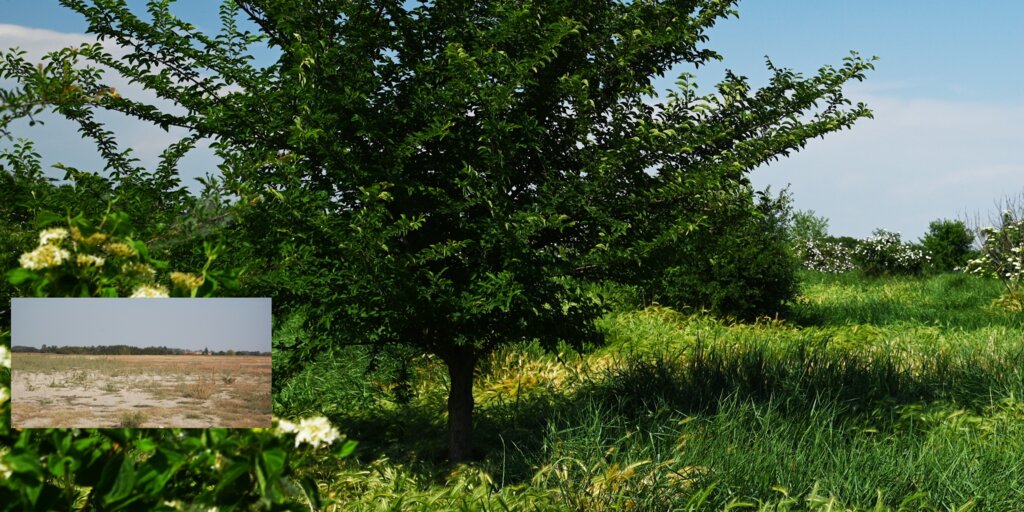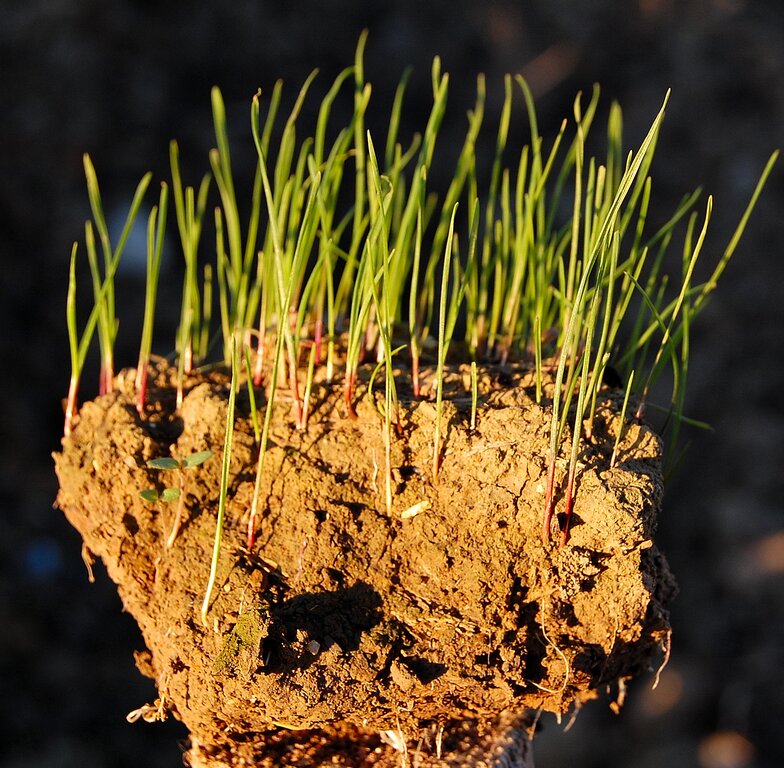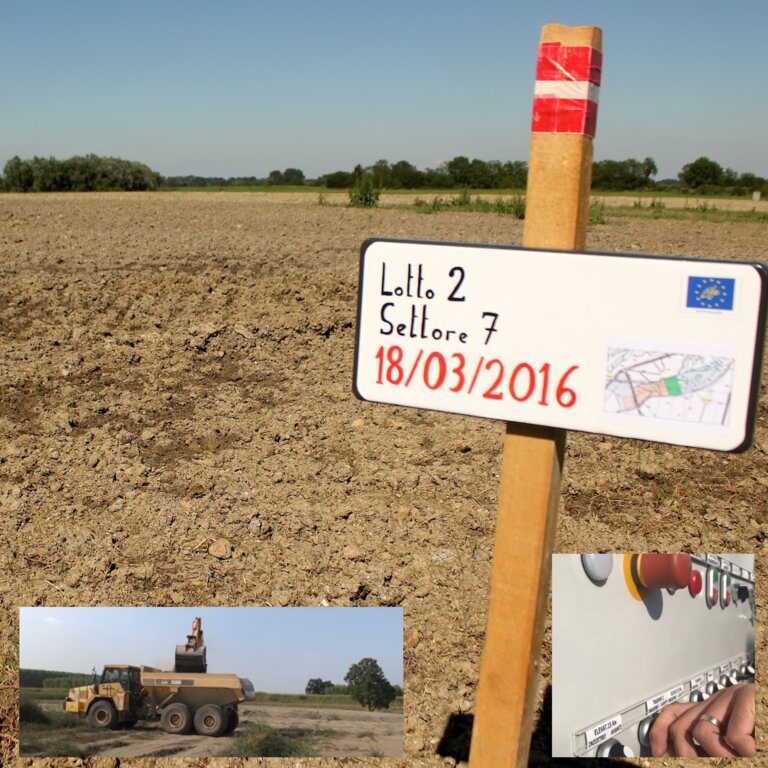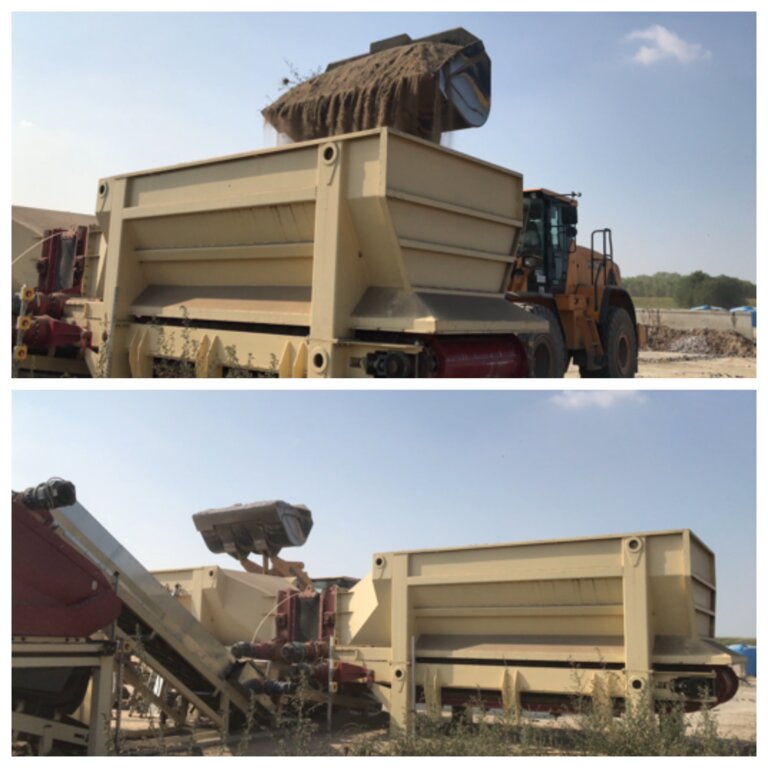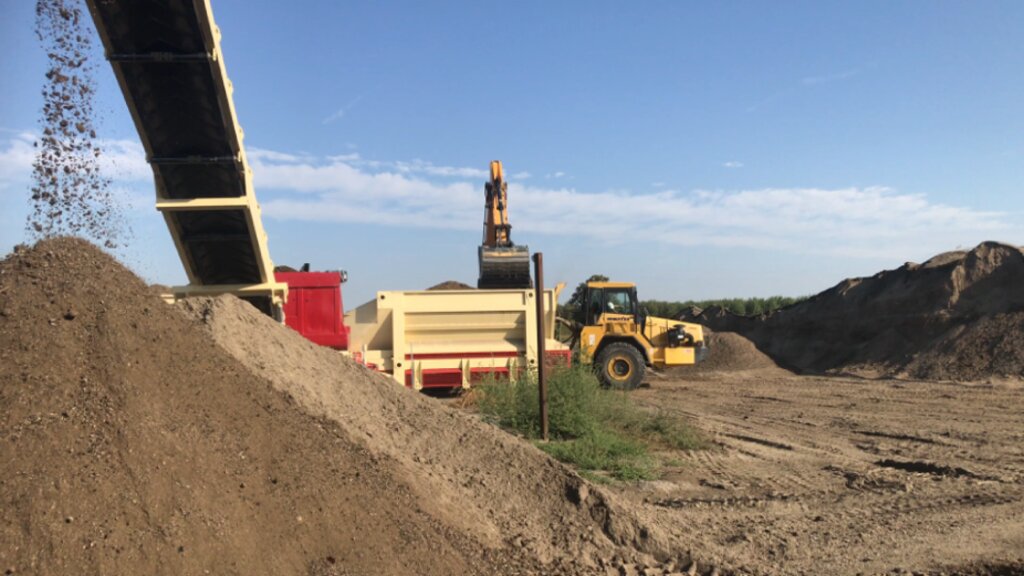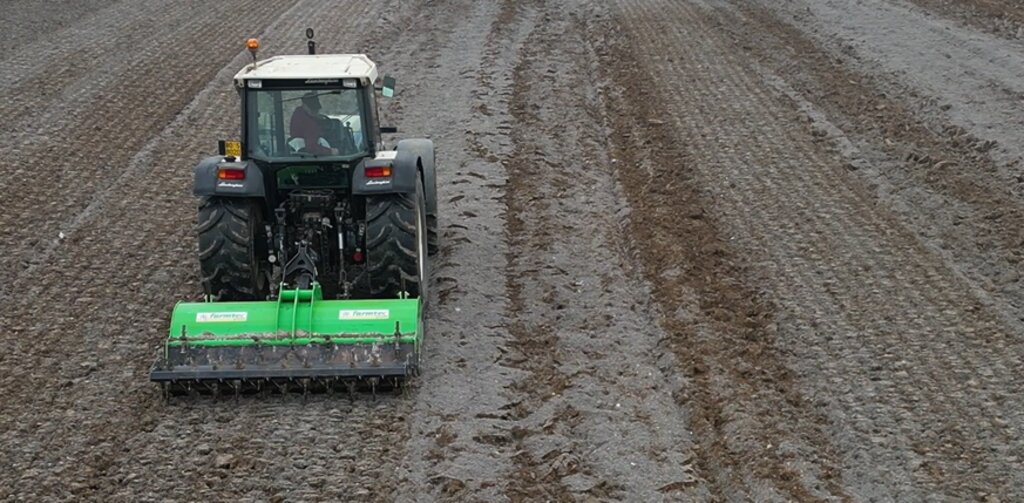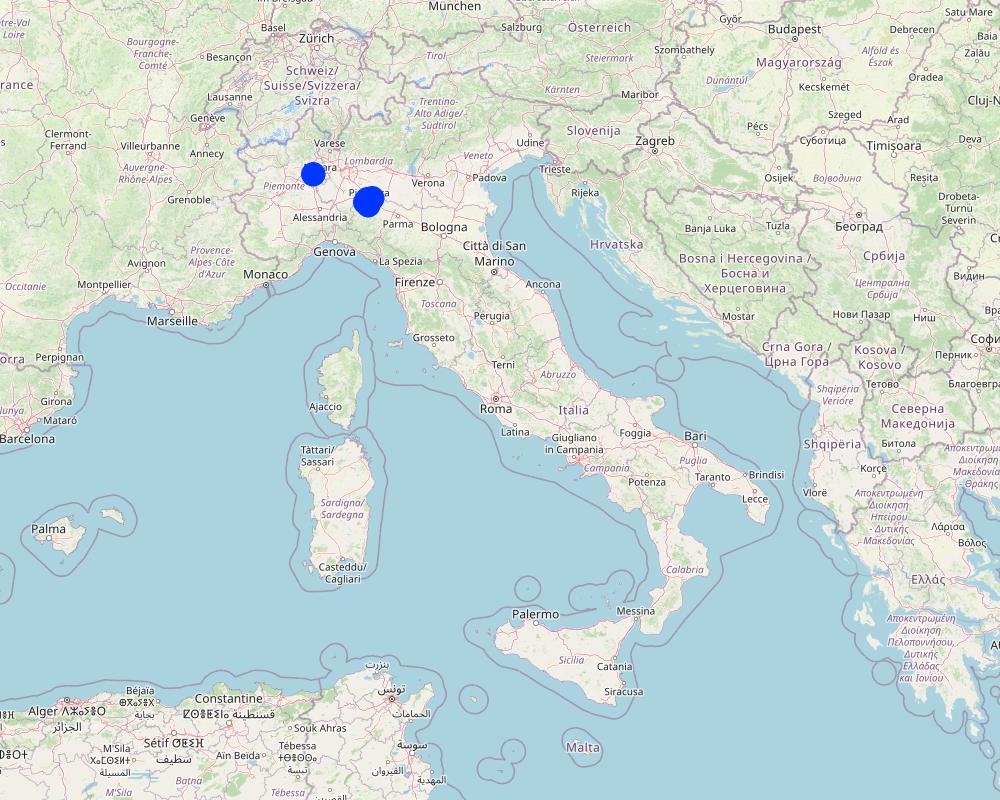Reconstitution of Soils [Italy]
- Creation:
- Update:
- Compiler: Chiara Cassinari
- Editor: –
- Reviewers: William Critchley, Rima Mekdaschi Studer
Ricostituzione
technologies_7346 - Italy
View sections
Expand all Collapse all1. General information
1.2 Contact details of resource persons and institutions involved in the assessment and documentation of the Technology
Key resource person(s)
land user:
Manfredi Paolo
mcm Ecosistemi
Italy
co-compiler:
Name of project which facilitated the documentation/ evaluation of the Technology (if relevant)
NEW LIFE Project (NEW LIFE)Name of the institution(s) which facilitated the documentation/ evaluation of the Technology (if relevant)
m.c.m Ecosistemi (m.c.m Ecosistemi)1.3 Conditions regarding the use of data documented through WOCAT
The compiler and key resource person(s) accept the conditions regarding the use of data documented through WOCAT:
Ja
1.4 Declaration on sustainability of the described Technology
Is the Technology described here problematic with regard to land degradation, so that it cannot be declared a sustainable land management technology?
Nee
Comments:
Reconstitution is a technology that counters land degradation and according to the theory of "Circular Economy" it's a sustainable land management technology
1.5 Reference to Questionnaire(s) on SLM Approaches (documented using WOCAT)
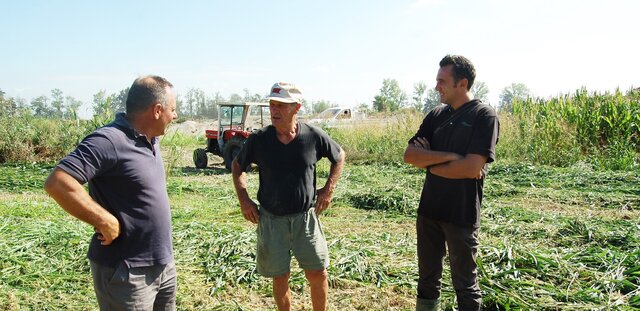
Reconstitution of Soils Approach [Italy]
Reconstitution of soils is a patented pedotechnology that brings benefits to degraded soils. Simultaneously, it raises awareness of the potential of restoring soil fertility through recycling. The approach starts with the identification of the soil issue, and the technology is then planned, implemented and promoted through a consortium.
- Compiler: Chiara Cassinari
2. Description of the SLM Technology
2.1 Short description of the Technology
Definition of the Technology:
Reconstitution of soils is a pedotechnique based on the treatment of organic and non-organic pedomaterials to achieve benefits in areas with barren, degraded, desertified and/ or sealed soils.
2.2 Detailed description of the Technology
Description:
Reconstitution of soils to generate an Anthroposol is a technology based on the treatment of organic and non-organic pedomaterials or “matrices” (from “matrix” in Latin: everything that is the foundation of something) to achieve ecosystem benefits, especially in areas with degraded, desertified, barren and/or sealed soils. The technology applies a conceptual model based on the production of new soil aggregates with targeted environmental and soil characters generated via a chemico-mechanical process that entails reusing residues of specific origin. The activity is consistent with the principles of a “Circular Economy”, applying restoration ecology, use of compatible waste and saving the non-renewable resource of soil. Reconstitution is covered by two patents of the mcm Ecosistemi s.r.l. company.
Reconstitution applies the process to two groups of pedomaterials. Firstly, primary matrices (matrices I), represent the main material to be converted into fertile soil. These could be degraded soil itself or inorganic mineral pedomaterials. Secondly, secondary matrices (matrices II) refer to byproducts and waste from production activities. Secondary matrices are divided into two. First, organic - from wood and cellulose processing production activities and from textile and agro-food industries. These are characterized by a high organic component with a high carbon/nitrogen ratio, and a high presence of plant fibres. Second, mineral matrices - especially from mining, the preparation of drinking and industrial water and the management of hydroelectric reservoirs and internal canals. There are four stages.
1) Loading: After the chemico-physico-environmental and rheological characterization of matrices I and II, the materials are selected according to the type of soil desired and then loaded in the plant. Dosage is calculated through an application program (PEDOGÉNIA), which estimates the chemical properties of the finished product.
2) Mixing: The matrices undergo mechanical mixing under controlled humidity.
3) Disaggregation: Breakup and defibering through rotating movements at variable power.
4) Reconstitution: Specifically calibrated cyclic compression and formation of reconstituted soil aggregates.
The treatment generates an Anthroposol whose characters and properties are different from the materials of origin.
The properties of the reconstituted soils and the technical-economic sustainability of the pedotechnology have been demonstrated over the years with agronomical tests and experiments, as well as comparative analysis between degraded soils and reconstituted soils. This demonstrates the reconstituted soil’s ability to create a stable pedosystem to carry out its basic functions - storage, filtration, transformation of nutrients and biodiversity pools - for various forms of land use, and ecosystem benefits. Agroforestry restoration with reconstitution has social impact, as it is demonstrated by a EU project (“New Life”), where the Park of Trebbia river has increased utility to people after restoration. Agronomic restoration allows farmers to increase yields using less fertilizer and water. Another environmental and economic advantage is that manufacturing companies which produce waste can reduce costs through the recycling process of reconstitution. For reconstitution, a plant has to be installed near the land to be restored; an overview is presented in 4.1. In addition, earth moving vehicles are needed for the transport and placement of reconstituted soil.
2.3 Photos of the Technology
2.4 Videos of the Technology
Comments, short description:
youtube video
https://www.youtube.com/watch?v=nF3nl4S5X8M
Reconstitution plant
Date:
18/12/2024
Location:
Piacenza, Loc. Mortizza
Name of videographer:
Paolo Manfredi
Comments, short description:
youtube video
https://www.youtube.com/watch?v=Kjy95Kz-e70
Construction site: collection of degraded soil to be reconstituted
Date:
18/12/2018
Location:
Piacenza, Gossolengo
Name of videographer:
Paolo Manfredi
2.5 Country/ region/ locations where the Technology has been applied and which are covered by this assessment
Country:
Italy
Region/ State/ Province:
Emilia Romagna, Piacenza; Piemonte, Vicolungo
Specify the spread of the Technology:
- evenly spread over an area
If precise area is not known, indicate approximate area covered:
- 1-10 km2
Is/are the technology site(s) located in a permanently protected area?
Nee
Map
×2.6 Date of implementation
If precise year is not known, indicate approximate date:
- less than 10 years ago (recently)
2.7 Introduction of the Technology
Specify how the Technology was introduced:
- during experiments/ research
- through projects/ external interventions
Comments (type of project, etc.):
Regional, National and International projects
3. Classification of the SLM Technology
3.1 Main purpose(s) of the Technology
- improve production
- reduce, prevent, restore land degradation
- adapt to climate change/ extremes and its impacts
- create beneficial economic impact
- create beneficial social impact
3.2 Current land use type(s) where the Technology is applied
Land use mixed within the same land unit:
Ja
Specify mixed land use (crops/ grazing/ trees):
- Agroforestry

Cropland
- Annual cropping
Annual cropping - Specify crops:
- cereals - maize
- tomato, fodder crops
Number of growing seasons per year:
- 2
Is intercropping practiced?
Nee
Is crop rotation practiced?
Ja
If yes, specify:
maize - wheat - tomato

Forest/ woodlands
- (Semi-)natural forests/ woodlands
- Tree plantation, afforestation
Type of (semi-)natural forest:
- subtropical dry forest natural vegetation
Tree plantation, afforestation: Specify origin and composition of species:
- Mixed varieties
Type of tree plantation, afforestation:
- subtropical dry forest plantation
Type of tree:
- Acacia species
- Populus species
- Salix species
Are the trees specified above deciduous or evergreen?
- mixed deciduous/ evergreen
Products and services:
- Nature conservation/ protection
- Recreation/ tourism
- Protection against natural hazards
3.3 Has land use changed due to the implementation of the Technology?
Has land use changed due to the implementation of the Technology?
- Yes (Please fill out the questions below with regard to the land use before implementation of the Technology)
Land use mixed within the same land unit:
Ja
Specify mixed land use (crops/ grazing/ trees):
- Agroforestry
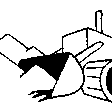
Mines, extractive industries
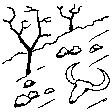
Unproductive land
Specify:
degraded, desertified and sealed soils
3.4 Water supply
Water supply for the land on which the Technology is applied:
- mixed rainfed-irrigated
3.5 SLM group to which the Technology belongs
- integrated soil fertility management
- waste management/ waste water management
- ecosystem rehabilitation
3.6 SLM measures comprising the Technology

agronomic measures
- A2: Organic matter/ soil fertility
- A4: Subsurface treatment

vegetative measures
- V1: Tree and shrub cover

structural measures
- S11: Others

management measures
- M6: Waste management (recycling, re-use or reduce)
- M7: Others

other measures
Specify:
addition of organic matter, new soil aggregates, increase water holding capacity
3.7 Main types of land degradation addressed by the Technology

soil erosion by water
- Wt: loss of topsoil/ surface erosion
- Wo: offsite degradation effects

soil erosion by wind
- Et: loss of topsoil

chemical soil deterioration
- Cn: fertility decline and reduced organic matter content (not caused by erosion)
- Ca: acidification
- Cs: salinization/ alkalinization

physical soil deterioration
- Pc: compaction
- Pk: slaking and crusting
- Pi: soil sealing

biological degradation
- Bc: reduction of vegetation cover
- Bh: loss of habitats
- Bq: quantity/ biomass decline
- Bs: quality and species composition/ diversity decline
- Bl: loss of soil life

water degradation
- Ha: aridification
3.8 Prevention, reduction, or restoration of land degradation
Specify the goal of the Technology with regard to land degradation:
- reduce land degradation
- restore/ rehabilitate severely degraded land
4. Technical specifications, implementation activities, inputs, and costs
4.1 Technical drawing of the Technology
Technical specifications (related to technical drawing):
Reconstituted technology: phases of work:
1) Loading: After the chemico-physico-environmental and rheological characterization of matrices I and II, the materials are selected and dosed
2) Mixing: The matrices undergo mechanical mixing under controlled humidity
3) Disaggregation through rotating movements at variable power
4) Reconstitution: Specifically calibrated cyclic compression and formation of reconstituted soil aggregates.
Author:
Paolo Manfredi
Date:
12/04/2023
4.2 General information regarding the calculation of inputs and costs
Specify how costs and inputs were calculated:
- per Technology area
Indicate size and area unit:
10 hectares
other/ national currency (specify):
EUR
If relevant, indicate exchange rate from USD to local currency (e.g. 1 USD = 79.9 Brazilian Real): 1 USD =:
0.89
Indicate average wage cost of hired labour per day:
123.00, gross income
4.3 Establishment activities
| Activity | Timing (season) | |
|---|---|---|
| 1. | characterization of the intervention site | no timing |
| 2. | morphological planning | no timing |
| 3. | environmental planning | no timing |
| 4. | pedo-agronomic planning | no timing |
| 5. | moving-plant placement only if the area to be restored is distant from the area where the permanent plant is located | no timing |
| 6. | degraded soil removal and collect | after harvest of crops, if there are |
| 7. | reconstitution | no timing |
| 8. | replacement of reconstituted soil | no timing |
| 9. | final soil placement | no timing |
| 10. | site-specific planting to make soil ready for use | dependence of plants species |
| 11. | land use | no timing |
Comments:
The reconstitution plants are 2: one is fixed that is located in an area, the other is a moving-plant: that is it can be located near the area to be restored.
According to the distance between the intervention site and the fixed plant it can be more useful using the moving-plant
4.4 Costs and inputs needed for establishment
| Specify input | Unit | Quantity | Costs per Unit | Total costs per input | % of costs borne by land users | |
|---|---|---|---|---|---|---|
| Labour | 3 Workers | person/day | 232.0 | 123.0 | 28536.0 | 100.0 |
| Equipment | Construction area - mobile plant | number | 1.0 | 30000.0 | 30000.0 | 100.0 |
| Equipment | Earth moving vehicles | number | 2.0 | 20000.0 | 40000.0 | 100.0 |
| Other | Matrices to be used | m3 | 75000.0 | 15.0 | 1125000.0 | |
| Other | Reconstitution | m3 | 100000.0 | 2.5 | 250000.0 | 100.0 |
| Total costs for establishment of the Technology | 1473536.0 | |||||
| Total costs for establishment of the Technology in USD | 1655658.43 | |||||
If land user bore less than 100% of costs, indicate who covered the remaining costs:
Costs related to the matrices to be used and transport (1125000.00 EUR) are covered by company producing waste used. The costs to dispose of matrices II are much higher than taking them to the reconstitution plant.
Comments:
degraded land value 0 EUR
restored area value 390000 EUR
restoration using allocation of natural soil (8 EUR/m3, cost of natural soil in Piacenza) added to transport costs = 2100000.00 EUR
restoration using reconstituted soil technology = 28536 + 30000 + 40000 + 250000.00 EUR because 1125000.00 EUR are covered by company producing waste and so not spent for restoration.
Cost related to construction area and mobile plant are the costs for the set up of the area where to put the mobile plant and for it' transport to the intervention site.
4.5 Maintenance/ recurrent activities
| Activity | Timing/ frequency | |
|---|---|---|
| 1. | Ordinary plant maintenance | every 6 months or when needed |
| 2. | Reconstituted soil analysis | every 6 months |
4.6 Costs and inputs needed for maintenance/ recurrent activities (per year)
| Specify input | Unit | Quantity | Costs per Unit | Total costs per input | % of costs borne by land users | |
|---|---|---|---|---|---|---|
| Labour | 1 Worker | person/day | 20.0 | 123.0 | 2460.0 | 100.0 |
| Labour | 3 Laboratory staff | person/day | 100.0 | 115.0 | 11500.0 | 100.0 |
| Total costs for maintenance of the Technology | 13960.0 | |||||
| Total costs for maintenance of the Technology in USD | 15685.39 | |||||
4.7 Most important factors affecting the costs
Describe the most determinate factors affecting the costs:
The most important factor affecting costs could be the transport of degraded soil or matrices I to be used to the restoration site in the case of soil sealed
5. Natural and human environment
5.1 Climate
Annual rainfall
- < 250 mm
- 251-500 mm
- 501-750 mm
- 751-1,000 mm
- 1,001-1,500 mm
- 1,501-2,000 mm
- 2,001-3,000 mm
- 3,001-4,000 mm
- > 4,000 mm
Specify average annual rainfall (if known), in mm:
891.02
Specifications/ comments on rainfall:
May: average monthly regionally anomaly +230% (heavy rains); October: heavy rains
February 2023 is the month with less rain 27.6 mm; in May is the rainiest 250.7 mm
Indicate the name of the reference meteorological station considered:
Bulletin ARPAE 2023
Agro-climatic zone
- sub-humid
mean annual temperature 14.4 °C Bulletin ARPAE 2023
5.2 Topography
Slopes on average:
- flat (0-2%)
- gentle (3-5%)
- moderate (6-10%)
- rolling (11-15%)
- hilly (16-30%)
- steep (31-60%)
- very steep (>60%)
Landforms:
- plateau/plains
- ridges
- mountain slopes
- hill slopes
- footslopes
- valley floors
Altitudinal zone:
- 0-100 m a.s.l.
- 101-500 m a.s.l.
- 501-1,000 m a.s.l.
- 1,001-1,500 m a.s.l.
- 1,501-2,000 m a.s.l.
- 2,001-2,500 m a.s.l.
- 2,501-3,000 m a.s.l.
- 3,001-4,000 m a.s.l.
- > 4,000 m a.s.l.
Indicate if the Technology is specifically applied in:
- not relevant
5.3 Soils
Soil depth on average:
- very shallow (0-20 cm)
- shallow (21-50 cm)
- moderately deep (51-80 cm)
- deep (81-120 cm)
- very deep (> 120 cm)
Soil texture (topsoil):
- coarse/ light (sandy)
- medium (loamy, silty)
Soil texture (> 20 cm below surface):
- medium (loamy, silty)
- fine/ heavy (clay)
Topsoil organic matter:
- medium (1-3%)
- low (<1%)
If available, attach full soil description or specify the available information, e.g. soil type, soil PH/ acidity, Cation Exchange Capacity, nitrogen, salinity etc.
Following the soil characterization (data are mean of 30 soil samples) of the last area of intervention with reconstitution; the data describes soil condition before reconstitution.
The soil texture is silty-loam
The aggregate stability index describes soils with poor stability
pH (1:2.5 in H2O) 6.98 ± 0.37
EC (saturated paste) 0.93 ± 0.41 dS m-1
tot CaCO3 10.33 ± 4.36 g kg-1 SS
active CaCO3 3.08 ± 1.24 g kg-1 SS
tot C 10.62 ± 3.68 g kg-1 SS
organic C 10.26 ± 3.44 g kg-1 SS
tot N 1.47 ± 0.43 g kg-1 SS
HA + FA 2.54 ± 1.26 g kg-1 SS
Olsen P 87.83 ± 44.19 mg kg-1 SS
available Fe 74.68 ± 32.97 mg kg-1 SS
available Mn 27.92 ± 15.78 mg kg-1 SS
available Zn 2.30 ± 1.72 mg kg-1 SS
available Cu 4.32 ± 1.34 mg kg-1 SS
soluble B 0.71 ± 0.25 mg kg-1 SS
assimilable K 21.61 ± 34.72 mg kg-1 SS
assimilable Mg 92.68 ± 28.13 mg kg-1 SS
CEC 26.22 ± 4.42 cmol(+) kg-1
exch Mg2+ 2.39 ± 0.50 cmol(+) kg-1
exch K+ 0.42 ± 0.33 cmol(+) kg-1
exch Na+ 0.48 ± 0.22 cmol(+) kg-1
exch Ca2+ 11.82 ± 4.75 cmol(+) kg-1
Chemical fertility is low, intrinsec fertility is poor, global fertility lower-intermidiate
In the link other data about soil analysis https://www.youtube.com/watch?v=-Hb0PcmSYGY&list=PLXcG4R_rAdFaqGnKCa0qaL6FcrafvU0VE
5.4 Water availability and quality
Ground water table:
5-50 m
Availability of surface water:
medium
Water quality (untreated):
for agricultural use only (irrigation)
Water quality refers to:
ground water
Is water salinity a problem?
Nee
Is flooding of the area occurring?
Nee
5.5 Biodiversity
Species diversity:
- low
Habitat diversity:
- low
5.6 Characteristics of land users applying the Technology
Sedentary or nomadic:
- Sedentary
Market orientation of production system:
- mixed (subsistence/ commercial)
- commercial/ market
Off-farm income:
- 10-50% of all income
Relative level of wealth:
- average
Individuals or groups:
- individual/ household
Level of mechanization:
- mechanized/ motorized
Gender:
- men
Age of land users:
- middle-aged
5.7 Average area of land used by land users applying the Technology
- < 0.5 ha
- 0.5-1 ha
- 1-2 ha
- 2-5 ha
- 5-15 ha
- 15-50 ha
- 50-100 ha
- 100-500 ha
- 500-1,000 ha
- 1,000-10,000 ha
- > 10,000 ha
Is this considered small-, medium- or large-scale (referring to local context)?
- medium-scale
5.8 Land ownership, land use rights, and water use rights
Land ownership:
- state
- individual, titled
Land use rights:
- open access (unorganized)
Water use rights:
- communal (organized)
Are land use rights based on a traditional legal system?
Ja
5.9 Access to services and infrastructure
health:
- poor
- moderate
- good
education:
- poor
- moderate
- good
technical assistance:
- poor
- moderate
- good
employment (e.g. off-farm):
- poor
- moderate
- good
markets:
- poor
- moderate
- good
energy:
- poor
- moderate
- good
roads and transport:
- poor
- moderate
- good
drinking water and sanitation:
- poor
- moderate
- good
financial services:
- poor
- moderate
- good
6. Impacts and concluding statements
6.1 On-site impacts the Technology has shown
Socio-economic impacts
Production
crop production
Quantity before SLM:
60%
Quantity after SLM:
100%
Comments/ specify:
increasing from 60% to 100%; in field trials, comparing low fertility soils and reconstituted soils, we tested that maize and wheat yields increased in reconstituted soils also using less fertilizers and water
https://www.youtube.com/watch?v=OKrAG6jrqXA
crop quality
Quantity before SLM:
70%
Quantity after SLM:
95%
Comments/ specify:
increasing from 70% to 100%; in field trials, comparing low fertility soils and reconstituted soils, we tested that wheat quality. in terms of proteins, increased in reconstituted soils
fodder production
Quantity before SLM:
65%
Quantity after SLM:
100%
Comments/ specify:
these increment are estimation
risk of production failure
Quantity before SLM:
40%
Quantity after SLM:
0
Comments/ specify:
decreasing from 40% to 0: this decreasing is an estimation, it's quite impossible a production failure using reconstituted soils because of their high fertility
https://www.youtube.com/watch?v=D0II3SGNhKo
land management
Quantity before SLM:
40
Quantity after SLM:
100
Comments/ specify:
simplified from 40% to 100%; because of the physical properties of reconstituted soils; because of the high organic carbon content and the mechanical treatment there is for example a reduction of soil crusting index in clay silty soils, reduction of soil compaction and soil skeleton
https://www.youtube.com/watch?v=Ld8YzGcx6Qw
Income and costs
expenses on agricultural inputs
Quantity before SLM:
60%
Quantity after SLM:
10%
Comments/ specify:
decreasing from 60% to 10%; in field trials, comparing low fertility soils and reconstituted soils, we tested that maize and wheat yields increased in reconstituted soils also using less fertilizers and water
farm income
Quantity before SLM:
60%
Quantity after SLM:
100%
Comments/ specify:
increasing from 60% to 100%; in field trials, comparing low fertility soils and reconstituted soils, we tested that maize and wheat yields increased in reconstituted soils and so also farm income increases
Socio-cultural impacts
food security/ self-sufficiency
Quantity before SLM:
60%
Quantity after SLM:
100%
Comments/ specify:
increasing from 60% to 100%; because of it's quite impossible a production failure using reconstituted soils because of their high fertility
cultural opportunities
Quantity before SLM:
10%
Quantity after SLM:
100%
Comments/ specify:
increasing from 10% to 100%; in a EU project (New Life) we tested that as a consequence the agroforestry restoration with reconstitution, the area of Park of Trebbia river has increased its social usability
https://www.youtube.com/watch?v=BJ8gFmV1Onc
recreational opportunities
Quantity before SLM:
10%
Quantity after SLM:
100%
Comments/ specify:
increasing from 10% to 100%; in the EU project (New Life) we tested that as a consequence the agroforestry restoration with reconstitution, the area of Park of Trebbia river has increased its social usability
Ecological impacts
Water cycle/ runoff
surface runoff
Quantity before SLM:
40%
Quantity after SLM:
15%
Comments/ specify:
decreasing from 40% to 15%, this is an estimation considering physical properties of reconstituted soils for example a reduction of soil crusting index in clay silty soils, reduction of soil compaction and soil skeleton
https://www.youtube.com/watch?v=rMazUuMaa6o
excess water drainage
Quantity before SLM:
40%
Quantity after SLM:
10%
Comments/ specify:
decreasing from 40% to 10%; some laboratory tests demonstrated that reconstitution improves soils permeability
https://www.youtube.com/shorts/oDhW-YlBjHA
Soil
soil moisture
Quantity before SLM:
40%
Quantity after SLM:
100%
Comments/ specify:
increasing from 40% to 100%; analyzing the water retention curves in many experimentation sites and comparing them with degraded soils, reconstituted soils has demonstrated to have better water holding capacity
https://www.youtube.com/watch?v=Yqtl4-xYMeo
https://www.youtube.com/watch?v=Qy_B3oCyIAM
soil cover
Quantity before SLM:
20%
Quantity after SLM:
100%
Comments/ specify:
increasing from 20% to 100%; in the EU project (New Life) after reconstituted soils replacement a lot of diversified herbaceous species were sprouted naturally
soil loss
Quantity before SLM:
50%
Quantity after SLM:
10%
Comments/ specify:
decreasing from 50% to 10%; this is an estimation considering physical properties of reconstituted soils as soil stability index
https://www.youtube.com/watch?v=g1GhoyIy4sk
soil crusting/ sealing
Quantity before SLM:
50%
Quantity after SLM:
0%
Comments/ specify:
decreasing from 50% to 0%; we tested a reduction of soil crusting index in clay silty soils
https://www.youtube.com/watch?v=aPQRoaYmrIQ
soil compaction
Quantity before SLM:
50%
Quantity after SLM:
100%
Comments/ specify:
decreasing from 50% to 100%; because of the high organic carbon content and the mechanical treatment there is for example a reduction of soil compaction in reconstituted soils
nutrient cycling/ recharge
Quantity before SLM:
60%
Quantity after SLM:
100%
Comments/ specify:
increasing from 60% to 100%; the high chemical fertility of reconstituted soils has been demonstrated in a lot of field tests
soil organic matter/ below ground C
Quantity before SLM:
10%
Quantity after SLM:
80%
Comments/ specify:
increasing from 10% to 80%; reconstituted soils has high organic carbon with a high C/N ratio; the SOC/clay is optimal
Biodiversity: vegetation, animals
Vegetation cover
Quantity before SLM:
20%
Quantity after SLM:
100%
Comments/ specify:
increasing from 20% to 100% in the EU project (New Life) after reconstituted soils replacement a lot of diversified herbaceous species sprouted naturally
https://www.youtube.com/watch?v=QFnUsjYLwfw
biomass/ above ground C
Quantity before SLM:
20%
Quantity after SLM:
100%
Comments/ specify:
increasing from 20% to 100%; in the EU project (New Life) after reconstituted soils replacement a lot of diversified herbaceous species sprouted naturally
plant diversity
Quantity before SLM:
20%
Quantity after SLM:
100%
Comments/ specify:
increasing from 20% to 100%; in the EU project (New Life) after reconstituted soils replacement a lot of diversified herbaceous species sprouted naturally
beneficial species
Quantity before SLM:
20%
Quantity after SLM:
80%
Comments/ specify:
increasing from 20% to 80%; in the EU project (New Life) after we planted over than 3,000 trees and shrubs of 16 indigenous species we recreated an ecological niche
https://www.youtube.com/watch?v=4Q8tqJNai3o
habitat diversity
Quantity before SLM:
10%
Quantity after SLM:
80%
Comments/ specify:
increasing from 20% to 80%; in the EU project (New Life) after we planted over than 3,000 trees and shrubs of 16 indigenous species we recreated an ecological niche
Climate and disaster risk reduction
flood impacts
Quantity before SLM:
40%
Quantity after SLM:
10%
Comments/ specify:
decreasing from 40% to 10%; because of high water holding capacity, high permeability, physical reconstituted soil properties
drought impacts
Quantity before SLM:
40%
Quantity after SLM:
0%
Comments/ specify:
decreasing from 40% to 0%; because of high water holding capacity, high permeability, phisical reconstituted soil properties
emission of carbon and greenhouse gases
Quantity before SLM:
40
Quantity after SLM:
10%
Comments/ specify:
decreasing from 40% to 10%; this is an estimation considering reconstituted soils microbial activity (tests about biological fertility), soil water content (humidity), soil temperature, nutrient availability and pH-value
https://www.youtube.com/watch?v=Ag5wzRVFg9s
https://www.youtube.com/watch?v=Anetp8gKaQg
6.2 Off-site impacts the Technology has shown
buffering/ filtering capacity
Quantity before SLM:
20%
Quantity after SLM:
50%
Comments/ specify:
increasing from 20% to 50%; because of the CaCO3 content of some matrices II
wind transported sediments
Quantity before SLM:
50%
Quantity after SLM:
10%
Comments/ specify:
decreasing from 50% to 10%; this is an estimation considering physical properties of reconstituted soils
6.3 Exposure and sensitivity of the Technology to gradual climate change and climate-related extremes/ disasters (as perceived by land users)
Gradual climate change
Gradual climate change
| Season | increase or decrease | How does the Technology cope with it? | |
|---|---|---|---|
| seasonal rainfall | wet/ rainy season | decrease | well |
Climate-related extremes (disasters)
Meteorological disasters
| How does the Technology cope with it? | |
|---|---|
| local rainstorm | well |
Climatological disasters
| How does the Technology cope with it? | |
|---|---|
| extreme winter conditions | moderately |
6.4 Cost-benefit analysis
How do the benefits compare with the establishment costs (from land users’ perspective)?
Short-term returns:
positive
Long-term returns:
very positive
How do the benefits compare with the maintenance/ recurrent costs (from land users' perspective)?
Short-term returns:
positive
Long-term returns:
very positive
Comments:
The recycle of suitable waste materials used defrays the reconstitution technology in short and long term
6.5 Adoption of the Technology
- 1-10%
Of all those who have adopted the Technology, how many did so spontaneously, i.e. without receiving any material incentives/ payments?
- 91-100%
6.6 Adaptation
Has the Technology been modified recently to adapt to changing conditions?
Ja
other (specify):
the Technology is partly modified to face every restoration project
Specify adaptation of the Technology (design, material/ species, etc.):
design, matrices to be used
6.7 Strengths/ advantages/ opportunities of the Technology
| Strengths/ advantages/ opportunities in the land user’s view |
|---|
| Strengths: to change soil class in Land Capability Classification, to improve soil workability, to create new soil aggregates (the organic matter is covered by fine soil mineral fractions) |
| Advantages: to increase soil fertility, to implement Circular Economy |
| Opportunities: to create a non-renewable resource (soil) and/or to restore it, to implement Circular Economy |
| Strengths/ advantages/ opportunities in the compiler’s or other key resource person’s view |
|---|
| Strengths: to produce the suitable soil for the environment where it will be placed |
| Advantages: to reduce the use of fertilizers |
| Opportunities: to restore soil using suitable waste, Circular Economy |
6.8 Weaknesses/ disadvantages/ risks of the Technology and ways of overcoming them
| Weaknesses/ disadvantages/ risks in the land user’s view | How can they be overcome? |
|---|---|
| Weaknesses: restoration of soil in very steep slope | studies about the physical behavior of reconstituted soil in steep slope |
| Disadvantages: demand exceed supply, concerning current number of workers employed in the reconstituted plant | formation of new workers |
| Risks: crisis of industries producing suitable waste | non-stop search for suitable waste to use |
| Weaknesses/ disadvantages/ risks in the compiler’s or other key resource person’s view | How can they be overcome? |
|---|---|
| Weaknesses: restoration of soil in very steep slope | studies about the physical behavior of reconstituted soil in steep slope |
| Disadvantages: contamined soils | studies about possibility of using reconstitution to clean soils |
|
Risks: the pedotechniques include all the anthropic activities that determine a growing influence of man on pedogenesis and pedolandscapes; they have to satisfy man needs while avoiding any undesirable environmental consequences (Dazzi et al., 2010). This is the main core of reconstitution of soils, but sometimes, the use of waste material, even if, environmental suitable, isn't understood because of waste are considered materials only for disposal. |
Dissemination concerning the laboratory analysis before the waste use, studies and research projects with University to test environmental suitability of reconstituted soils |
7. References and links
7.1 Methods/ sources of information
- field visits, field surveys
2 visits/survey a year
- interviews with land users
each land user where technology was adopted
When were the data compiled (in the field)?
15/03/2023
7.2 References to available publications
Title, author, year, ISBN:
The reconstitution pedotechnique: Applications, Manfredi P., Cassinari C., Trevisan M., 10.1016/j.eti.2021.102246
Available from where? Costs?
Scientific Journal
Title, author, year, ISBN:
The reconstitution: environmental restoration assessment by means of LCC and FCC, 10.6092/issn.2281-4485/8500
Available from where? Costs?
Scientific Journal
Title, author, year, ISBN:
Trees and shrubs monitoring using an ecological approach: the conclusion of the restoration project of Borgotrebbia landfill (Northern Italy), Manfredi P., Cassinari C., Meloni F., Stragliati L., Trevisan M., Giupponi L., 10.31031/EAES.2019.06.000635
Available from where? Costs?
Scientific Journal
Title, author, year, ISBN:
A new technology to restore soil fertility: Reconstitution, Manfredi P., Cassinari C., Francaviglia R., Trevisan M., 10.12871/00021857201933
Available from where? Costs?
Scientific Journal
Title, author, year, ISBN:
Growth and yield response of tomato (Solarium lycopersicum L.) to soil reconstitution technology, Manfredi P., Cassinari C., Gatti M., Trevisan M., 10.12871/00021857201916
Available from where? Costs?
Scientific Journal
Title, author, year, ISBN:
Test on the effects of reconstituted soil on emergency speed and root growth in maize, Manfredi P., Cassinari C., Salvi R., Battaglia R., Marocco A., Trevisan M., 10.1515/contagri-2018-0035
Available from where? Costs?
Scientific Journal
Title, author, year, ISBN:
Osservazione di Lycogala terrestre Fr. e Stemonitis axifera (Bull.) T. Macr. su suoli ricostituiti sabbiosi, Manfredi P., Salvi R., Bersan M., Cassinari C., Marocco A., Trevisan M.
Available from where? Costs?
Scientific Journal
Title, author, year, ISBN:
Relationship between hydraulic properties and plant coverage of the closed-landfill soils in Piacenza (Po Valley, Italy), Cassinari C., Manfredi P., Giupponi L., Trevisan M., Piccini C., 10.5194/se-6-929-2015
Available from where? Costs?
Scientific Journal
Title, author, year, ISBN:
Soil temperature fluctuations in a degraded and in a reconstituted soil, Manfredi P., Cassinari C., Trevisan M., ISBN 20385625
Available from where? Costs?
Scientific Journal
Title, author, year, ISBN:
Confronto tra dati produttivi di mais coltivato su terre ricostituite e terre naturali, Manfredi P., Tassi D., Cassinari C.
Available from where? Costs?
Scientific Journal
7.3 Links to relevant online information
Title/ description:
Ecosistemi web site
URL:
https://www.mcmecosistemi.com/
Title/ description:
Paolo Manfredi ResearchGate
URL:
https://www.researchgate.net/profile/Paolo-Manfredi-2
Title/ description:
Chiara Cassinari ResearchGate
URL:
https://www.researchgate.net/profile/Chiara-Cassinari
Title/ description:
All the publications with DOI mentioned above
Title/ description:
Ecosistemi YouTube channel
URL:
https://www.youtube.com/channel/UCOloFv-BLgvIVt9kBZuZyZg
7.4 General comments
Very useful questionnaire
Links and modules
Expand all Collapse allLinks

Reconstitution of Soils Approach [Italy]
Reconstitution of soils is a patented pedotechnology that brings benefits to degraded soils. Simultaneously, it raises awareness of the potential of restoring soil fertility through recycling. The approach starts with the identification of the soil issue, and the technology is then planned, implemented and promoted through a consortium.
- Compiler: Chiara Cassinari
Modules
No modules



